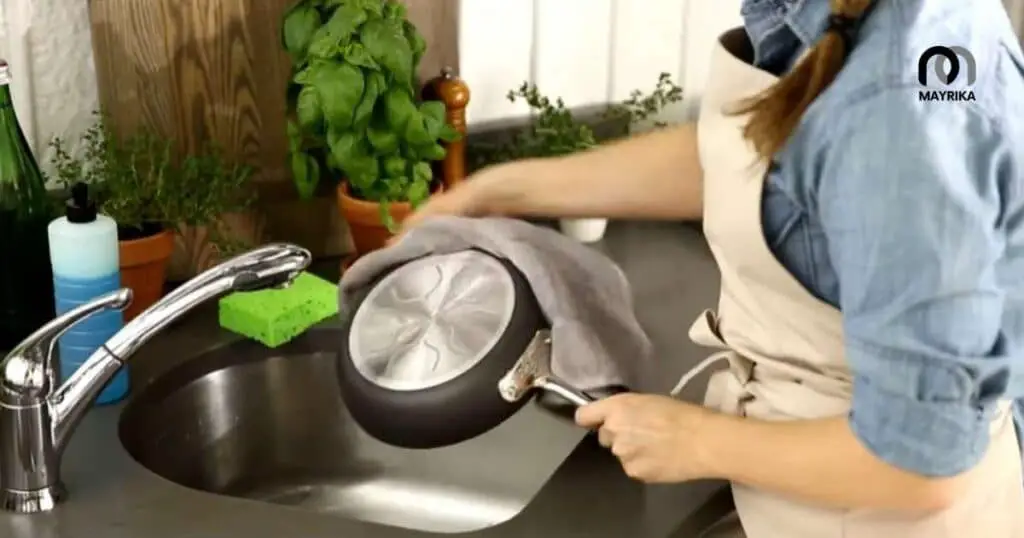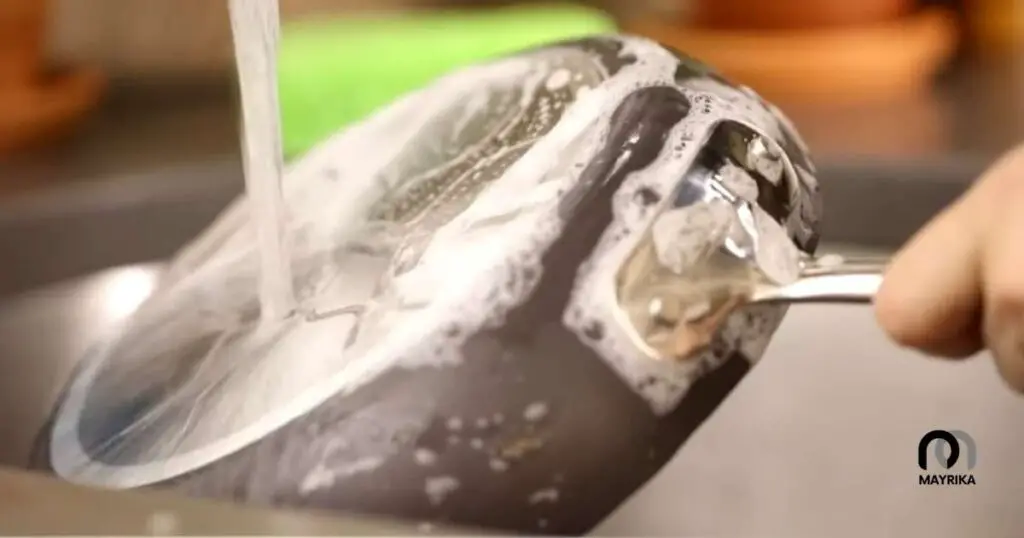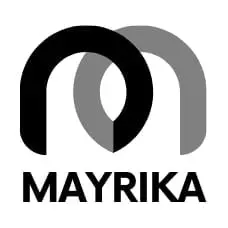Many people don’t know that there is a difference between hard anodized cookware and aluminum. Hard anodized cookware, by definition, should never be washed with soap and cold water or soaked in water.
The best way to clean these pots and pans is to wipe them down with soapy hot water after use.
If you are using the dishwasher for your hard anodized cookware, make sure not to put it on high heat as this will cause the coating to wear off prematurely.
To keep your pots looking new, all you need is some mild dish soap with warm water!
Many people think they can wash their hard-anodized pots and pans like any other metal pot, but they’re wrong!
But with the right tools, it doesn’t need to be a headache. This article will outline how to clean hard anodized cookware.
What are anodized pans?
Anodized aluminum is a metal that reacts to oxidation by forming a hard layer of aluminum oxide around the surface.
Aluminum, an element that never corrodes or rusts, is part of a family called “the noble metals” because they cannot form alloys with other ingredients.
Multiple colorants can be added to produce an endless variety of shades and colors by adding small amounts of various metals during the manufacturing process.
While still retaining the lightweight properties that make aluminum ideal for cooking and baking.
Anodized pans are made from hard-anodized aluminum (also called Type II anodic coatings). These durable and colorful pots are pot-lifetime pieces, though care needs to be taken when cleaning them.
Anodized pans have been treated with electricity to harden the coating inside and outside the pan. As a result, they’re good at retaining heat and cooking food evenly.
In addition, the chemical reaction between the metal in a pan and an electric current makes a much tighter bond than any other material, leading to more durable products.
As a result, anodized pans are twice as hard as stainless steel, meaning your eggs won’t stick, they’ll clean up more manageable, and you can use them without oil for baking!
What are the benefits of hard-anodized cookware?
Hard-anodized cookware is durable, convenient, and has a non-reactive property that will not allow toxic or reactive chemicals to seep into your food.
It also has no peeling or overheating, and due to its bonded construction, it will not chip like other cookware.
It’s the most challenging and colorful cookware you’ll ever find. However, it doesn’t react with food. It is often stick-resistant, and its exterior is also scratch-resistant, making it a perfect option for people who do a lot of cooking.
The best part? Hard-anodized pots and pans usually heat up faster than other types of pots and pans.
Because aluminum conducts heat better than other materials, sending more energy to the pan itself, which translates into higher temperatures at the pot or grill.
Regular cleaning of hard anodized cookware
Hard anodized cookware is a powerful tool in the kitchen that can be used for years. However, it has to be taken care of and cleaned regularly.
This blog post will guide you through the best way to clean your hard anodized cookware so that you don’t have to worry about food sticking or any other problems arising from not properly taking care of your pots and pans.

What to do before cleaning hard-anodized cooking pans?
It’s best to let your cookware cools entirely before you wash it. If the pieces are still hot, the dish soap can solidify on the surface, forming a difficult-to-remove film.
Hot soapy water can also loosen and lift grease from your cookware while simultaneously transferring any food particles to a pot or pan not yet washed (which will require extra scrubbing).
In this case, the key is patience when dealing with hard anodized pans with tough baked-on stuff – remember, they take a little more work than other pots and pans. You’re going to have to get those scrubs out from time to time!
How to clean hard anodized cooking pans?
To clean hard-anodized cookware, we recommend that you use a soft-bristled brush or soft sponge to clean your pan at the burnt food residue or stains with the help of soapy hot water.
Soap should not be used directly on cookware as some soaps have been known to strip an anodized finish.
Put your pan in the sink filled with hot soapy water and scrub any stuck-on food. Rinse well with water, then use a ball of steel wool or nylon pad to rub away stubborn cooked-on bits under running water.
Dishwasher-safe pans can be put through an intensive cycle for the extra-strength cleaning solution.
Many products can be used to clean hard-anodized cookware. For example, to remove tough stains, vinegar is recommended by most people.
All you need to do is put everything in a bucket and cover it with vinegar, and let it soak for about an hour.
To keep your pan looking beautiful, cook using lower heat settings and add one tablespoon of vegetable oil into the pan before cooking.
To help prevent sticking or building up stains, wipe out excess residue every night after a meal but don’t use harsh detergents.
5 Steps to cleaning hard-anodized cookware!
1) Soak it in warm soapy water for 10 minutes before cleaning. This will loosen all the stuck-on food, and hopefully, get rid of dirt. Remember to keep an eye on the sink and refill with hot water if you need to.
It’s a good idea to add a little bit of dish detergent because it helps break up the gunk that makes ceramic pans hard to clean – Fun tip: Pour kosher salt into your wet pot or pan before soaking!
2) Give everything a quick scrub with some stiff but not too rough nylon kitchen cleaners like these!
3) Rinse out entirely under running water as well as inside and out until really clean
4) Dry thoroughly with dishtowels
5) Use a non-abrasive sponge or soft sponge
The general advice is to scrape off any food particles. However, incorrectly scraping could scratch your cookware, so take your time to avoid this problem.
If you have a dishwasher with a hard-anodized finish, use the dishwasher instead of handwashing. There are fewer chances of scratching the anodized surface and damaging it permanently.
Lastly, if you have pans that have been subject to a lot of high heat deep-frying, use a metal utensil rather than something that may get embedded inside.
During scrapings like sandpaper or steel wool, the food particles – something abrasive cleaners will continue and worsen the scratches on your pan’s surface.

Cleaning hard anodized cookware exterior and interior
Cleaning hard anodized cookware exterior and interior surfaces is not as simple as one thinks. However, you can clean them by following a few steps and doing it without any professional help.
The exterior of hard anodized cookware is generally non-stick and very easy to clean. You can use warm soapy water or by hand with a wet sponge or brush, or you can do as we do; run it under the tap and rub gently with your hands until all stuck food/residue is removed. Even stubborn burnt food will come off easily.
The interior of hard anodized cookware provides the best non-stick surface. You can easily clean up food stains just with hot water without using any dishwashing liquid.
If you had burnt some food stains, you need to use some lemon juice or baking soda mixed in some water and clean it gently. After all the cleaning, rinse off the soap with water so that there is no trace of any cleaner left behind.
Things to avoid when cleaning hard-anodized cookware
When you clean your hard-anodized cookware, avoid the following:
- Strong household cleaners or abrasive scrubbing pads
- These can break down the coating on your cookware and lead to eventual corrosion
- Baking soda
It’s abrasive and may damage the surface of your pots and pans. Also, it doesn’t dissolve food very well compared to some of its other goodies in its package (chalk, cornstarch).
So it won’t get any stubborn stains out that baking soda cannot usually work with.
If you want cleaner dishes but don’t have Dawn dish soap or lemon juice, leave one side spray bottle empty except for water. Then, spray your dishes off with just water when they are caked.
Putting hard-anodized cookware in the dishwasher
Putting hard-anodized cookware in the dishwasher exposes it to both heat and harsh detergent.
Anodizing coats the uncoated metal with an aluminum oxide layer that is highly resistant to corrosion and scratching.
But this coating can be easily removed or “washed away” by exposure to a strong acid (like lemon juice) or alkali (like baking soda).
In addition, the hard-anodized surface will be pitted or worn away by abrasive material in the dishwashing process that contacts it for only an instant during its passage through the rinse water.
Hard anodized cookware should always be hand cleaned. However, it can be washed with soap if scrubbed while wet before being dried.
A dishwasher will damage and degrade your cookware. It is a very harsh environment for any cookware.
Dishwashers use high temperatures to warp aluminum and strip off the hard anodized surface on your “hard-anodized” or ceramic coating cookware.
It is always best to handwash these items so you won’t be disappointed with your investment in them like many home chefs are today!
Final Thoughts
Hard-anodized cookware is a type of aluminum metal that has been anodized. The process hardens the outer layer to withstand high heat and scratches, making them great for cooking with hot oil or other items.
However, that may scratch regular pots and pans like cast iron skillets. Therefore, it’s essential to keep your hard-anodized pan clean by following the above steps.
Before cleaning it to avoid scratching the surface, even more, clean harder next time, you use it. Hope after reading this “How to clean hard anodized cookware?” blog post, now cleaning your hard anodized cookware will be easy!
Avoid putting hard-anodized cookware in the dishwasher because it may cause damage to the surface. Dishwashers can be tough on pots and pans, so you should always hand wash them instead.
Hard anodized aluminum is a more durable material than regular aluminum or copper, for example.
When using steel wool or nylon pad, make sure that no sharp edges are leftover from rubbing against your pan’s surface, as this could scratch up your cooking gear!
Read Next: How To Clean Discolored Enamel Cookware?
FAQs
-
Can you use steel wool on hard anodized cookware?
The use of steel wool on any cookware could cause damage to the surface.
-
Can I put hard anodized cookware in the dishwasher?
The hard anodized surface is intended to be non-stick and is not made to withstand the high heat of the dishwasher.
The high heat of the dishwasher will result in the coating coming off of the surface, leaving the natural metal underneath exposed and susceptible to rust.
-
Is baking soda safe for hard-anodized cookware?
Baking soda is a great cleaner, but it is not safe for hard-anodized cookware. Baking soda can cause pitting in hard-anodized cookware.
Hard-anodized cookware is very durable, but it can easily develop pitting, which is permanent damage. So, no, baking soda is not safe for hard-anodized cookware.
-
Can you use Bar Keepers Friend on hard anodized cookware?
You can use Bar Keepers Friend on hard anodized cookware by gently rubbing the Bar Keepers Friend with a soft, non-abrasive sponge or cloth in a circular motion.
